A Solid-State High Voltage (HV) Relay represents a critical advancement in the realm of electrical switching technology. Unlike traditional electromechanical relays, which rely on mechanical components to open and close electrical circuits, solid-state HV relays utilize semiconductor devices to perform these functions without moving parts. This innovation brings a host of benefits in terms of reliability, longevity, speed, and efficiency, making them highly suitable for applications requiring high-voltage switching.

The Mechanics Behind Solid-State HV Relays At the core of a Solid-State HV Relay is the use of semiconductor materials such as silicon-controlled rectifiers (SCRs), thyristors, or metal-oxide-semiconductor field-effect transistors (MOSFETs). These components are capable of controlling high voltage and high current without the need for mechanical contacts, which can wear out or fail over time. The key principle of operation is that the relay uses a small electrical signal to control the larger high-voltage current, effectively acting as a switch that operates without the physical wear and tear typically associated with mechanical relays.